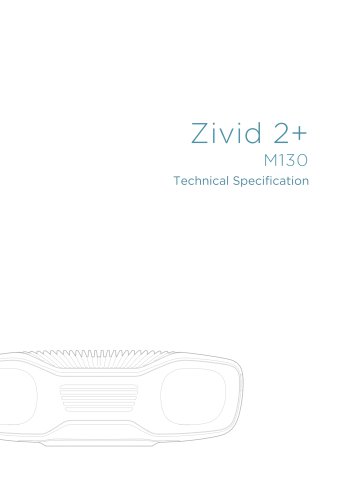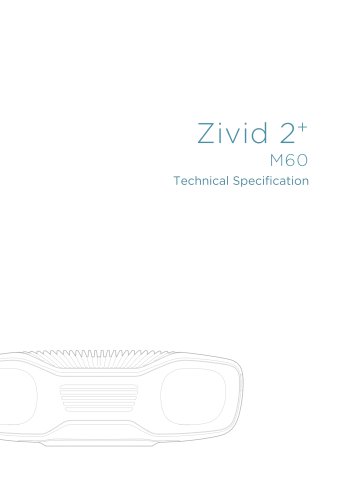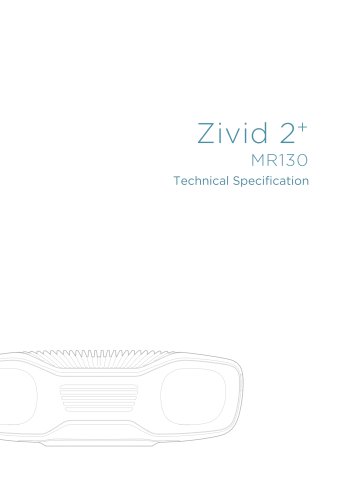
Catalog excerpts
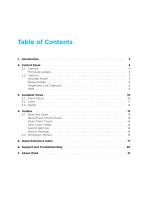
Table of Contents 1. Introduction . . . . . . . . . . . . . . . . . . . . . . . . . . . . . . . . . . . . . . . . . . . . . . 2. Control Panel . . . . . . . . . . . 2.1 Camera . . . . . . . . . . . . Firmware update . . . . . . 2.2 Capture . . . . . . . . . . . . Assisted Mode . . . . . . . Manual Mode . . . . . . . . Single and Live Captures HDR . . . . . . . . . . . . . . . 3. Available Views . 3.1 Point Cloud 3.2 Color . . . . . 3.3 Depth . . . . 4. Toolbar . . . . . . . . . . . . . . . . 4.1 Save and Open . . . . . . . Save/Export Point Cloud Open Point Cloud . . . . . Save Color Image...
Open the catalog to page 2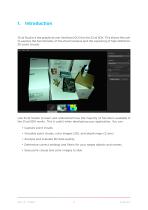
Zivid Studio is the graphical user interface (GUI) for the Zivid SDK. This allows the user to explore the functionality of the Zivid Cameras and the capturing of high definition 3D point clouds. Use Zivid Studio to learn and understand how the majority of functions available in the Zivid SDK works. This is useful when developing your application. You can: • Capture point clouds. • Visualize point clouds, color images (2D), and depth maps (Z axis). • Analyze and evaluate 3D data quality. • Determine correct settings and filters for your target objects and scenes. • Save point clouds and...
Open the catalog to page 3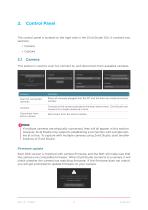
Control Panel The control panel is located on the right side in the Zivid Studio GUI. It contains two sections: • Camera • Capture 2.1 Camera This section is used to scan for, connect to, and disconnect from available cameras. Scan for connected cameras Show all cameras plugged into the PC and list them by model and serial number. Connect to the camera selected in the drop-down menu. Zivid Studio can connect to a single camera at a time. Disconnect from active camera Disconnect from the active camera. Note If multiple cameras are physically connected, they will all appear in this section....
Open the catalog to page 4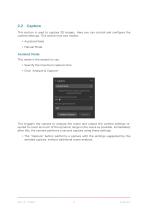
This section is used to capture 3D images. Here you can control and configure the camera settings. This section has two modes: • Assisted Mode • Manual Mode Assisted Mode This mode is the easiest to use. • Specify the maximum capture time • Click “Analyze & Capture” This triggers the camera to analyze the scene and output the camera settings required to cover as much of the dynamic range in the scene as possible. Immediately after this, the camera performs a second capture using these settings. • The “Capture” button performs a capture with the settings suggested by the assisted capture,...
Open the catalog to page 5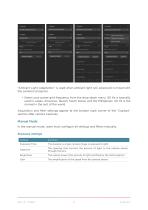
“Ambient Light Adaptation” is used when ambient light (AC powered) is mixed with the camera’s projector. • Select your power grid frequency from the drop-down menu. 60 Hz is typically used in Japan, Americas, Taiwan, South Korea, and the Philippines. 50 Hz is the normal in the rest of the world. Acquisition and filter settings appear at the bottom right corner of the “Capture” section after camera captures. Manual Mode In the manual mode, users must configure all settings and filters manually. Exposure settings Setting Exposure Time The duration a single camera image is exposed to light....
Open the catalog to page 6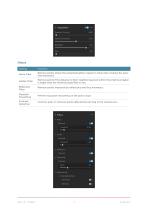
Filters Setting Noise Filter Remove points where the projected pattern signal-to-noise-ratio is below the specified threshold. Outlier Filter Remove points if the distance to their neighboring pixels within the small local region is larger than the threshold specified in mm. Reflection Filter Remove points impacted by reflections and thus erroneous. Gaussian Smoothing Perform Gaussian smoothing on the point cloud. Contrast Distortion Corrects and/ or removes points affected by blurring in the camera lens.
Open the catalog to page 7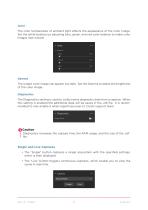
Color The color temperature of ambient light affects the appearance of the color image. Set the white balance by adjusting blue, green, and red color balance to make color images look natural. Gamma The output color image can appear too dark. Set the Gamma to adjust the brightness of the color image. Diagnostics The Diagnostics setting is used to collect extra diagnostic data from a capture. When this setting is enabled the additional data will be saved in the .zdf file. It is recommended to only enable it when reporting issues to Zivid’s support team. Caution Diagnostics increases the...
Open the catalog to page 8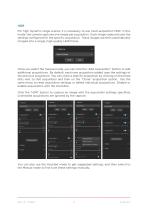
HDR For high dynamic range scenes, it is necessary to use multi-acquisition HDR. In this mode, the camera captures one image per acquisition. Each image captured uses the settings configured for the specific acquisition. These images are then automatically merged into a single, high-quality HDR frame. Once you select the manual mode, you can click the “Add Acquisition” button to add additional acquisitions. By default, each new acquisition added uses the settings of the previous acquisition. You can clone a specific acquisition by clicking on the three dots next to that acquisition and then...
Open the catalog to page 9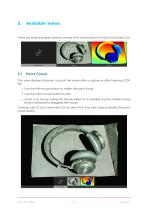
Available Views There are three available views to choose from at the bottom of the Zivid Studio GUI. 3.1 Point Cloud This view displays the point cloud of the scene after a capture or after loading a ZDF file. • Use the left mouse button to rotate the point cloud • Use the right mouse button to pan. • Zoom in or out by rolling the mouse wheel or, if available, by the middle mouse button followed by dragging the mouse. Turning color (C & D) and mesh (D) on and off in this view helps evaluate the point cloud quality.
Open the catalog to page 10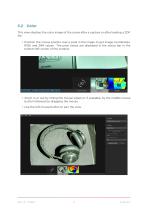
This view displays the color image of the scene after a capture or after loading a ZDF file. • Position the mouse pointer over a pixel in the image to get image coordinates, RGB, and SNR values. The pixel values are displayed in the status bar in the bottom left corner of the window. • Zoom in or out by rolling the mouse wheel or, if available, by the middle mouse button followed by dragging the mouse. • Use the left mouse button to pan the view.
Open the catalog to page 11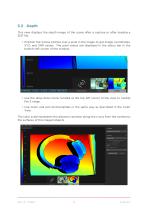
3.3 Depth This view displays the depth image of the scene after a capture or after loading a ZDF file. • Position the mouse pointer over a pixel in the image to get image coordinates, XYZ, and SNR values. The pixel values are displayed in the status bar in the bottom left corner of the window. • Use the drop-down menu located at the top left corner of the view to modify the Z range. • Use zoom and pan functionalities in the same way as described in the Color View. The color scale represents the distance variation along the z-axis from the camera to the surfaces of the imaged objects.
Open the catalog to page 12All Zivid catalogs and technical brochures
-
Zivid 2+M130
19 Pages
-
Zivid 2+ M60
19 Pages
-
Zivid 2+ MR130
19 Pages
-
Zivid One+ datasheet
21 Pages
-
Zivid Two datasheet
15 Pages
-
Zivid One+ user guide
18 Pages
-
Zivid Two user guide
22 Pages


